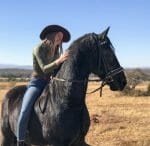Guest Author Sanne from the blog Hooves Around The World shares 7 ways you and your horse can benefit from fun and simple dressage exercises Including 5 exercises anyone can do!
Lately, you have been stuck in the same place with riding. You feel like you aren’t improving, not getting worse but definitely not getting better. You know that dressage is the basis of all other disciplines, but it’s just … boring.
Whether you’re a showjumper, dressage rider, endurance fanatic, or a rider in any other discipline, there are ways to benefit and most importantly to have fun doing flatwork and dressage exercises.
Let’s get into the 7 ways that you and your horse can benefit from fun dressage exercises that anyone can do.
- Your horse will have a softer mouth
- Your horse will be more forward going
- Your horse will be easier to direct and quicker to your hand and leg aids
- Much less bouncing around in the saddle
- Added balance for both you and your horse
- You’ll have a much easier time getting around the show jumping course or practicing any other discipline
- A more solid dressage basis will make dressage fun again
After going through the 7 benefits of a good dressage basis for you and your horse, I have also created and added 5 exercises for you.
As an ex-professional dressage rider, turned trails guide: Ultimate list of 35 different careers in the horse world – Hooves Around the World, I still use these exercises with my trails ponies! These exercises are fun, simple, and doable for any horse and anyone and will help you tremendously in your riding.
Before we start, if you suspect your horse to be in pain, check that out first as these problems might be due to teeth issues, stomach ulcers, or another medical problem.
Benefit 1: Your horse will have a softer mouth
The typical riding school pony problem is a horse that is quite lazy, but hard in their mouth. This can be very frustrating as it makes riding a lot less fun and it feels so very contradicting.
If your horse does end up bolting you can pull and pull all you want but your lazy horse will not slow down. These horses hang into your hands and walk, trot and canter with their bum in the air, so what we want to achieve is to lighten up their forehand and activate their bum.
It’s often thought that dressage is all about pulling your horse into the correct frame and looking fancy, which is really not the case.
When your horse is active and relaxed, that dressage frame will come automatically, no need to touch those reins! Fortunately, you don’t need an expensive trainer or incredibly difficult dressage exercises to achieve an active bum.
When your horse comes off their forehand, they’ll have a much softer mouth and you’ll enjoy the ride much more.
Benefit 2: Your horse will be more forward going
Forward going, but not in the bolting kinda way. You often see that horses that are on the forehand have pretty fast gaits but they still somehow feel and look lazy.
They also have a habit of speeding up so much in the trot that they fall into a canter or just keep trotting full speed through the arena, but we want to jump into a nice active canter that’s easy to sit! This all comes back to an active bum and a balanced horse and rider.
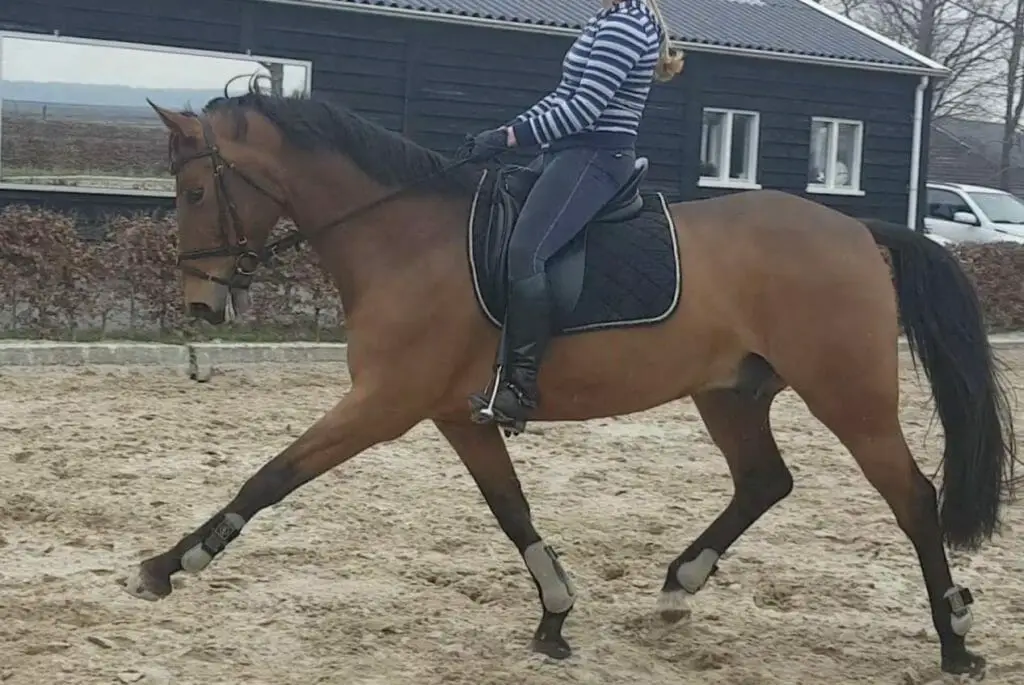
Coming off the forehand and having an active bum means lots of freedom for the front legs to stretch all the way out.
Benefit 3: Your horse will be easier to direct and quicker to your hand and leg aids
When you practice the easy dressage exercises at the end of this article for a while, you’ll notice the difference in your horse’s reaction to your aids.
Your horse will have a strong hind end and lots more balance, which means a happier and easier horse to ride. Don’t be surprised if your horse will react to a light half-halt and a small squeeze with your legs perfectly.
This is not only nice for dressage riders but also very helpful for jumpers, eventers, endurance riders and also makes for much more pleasant hacks.
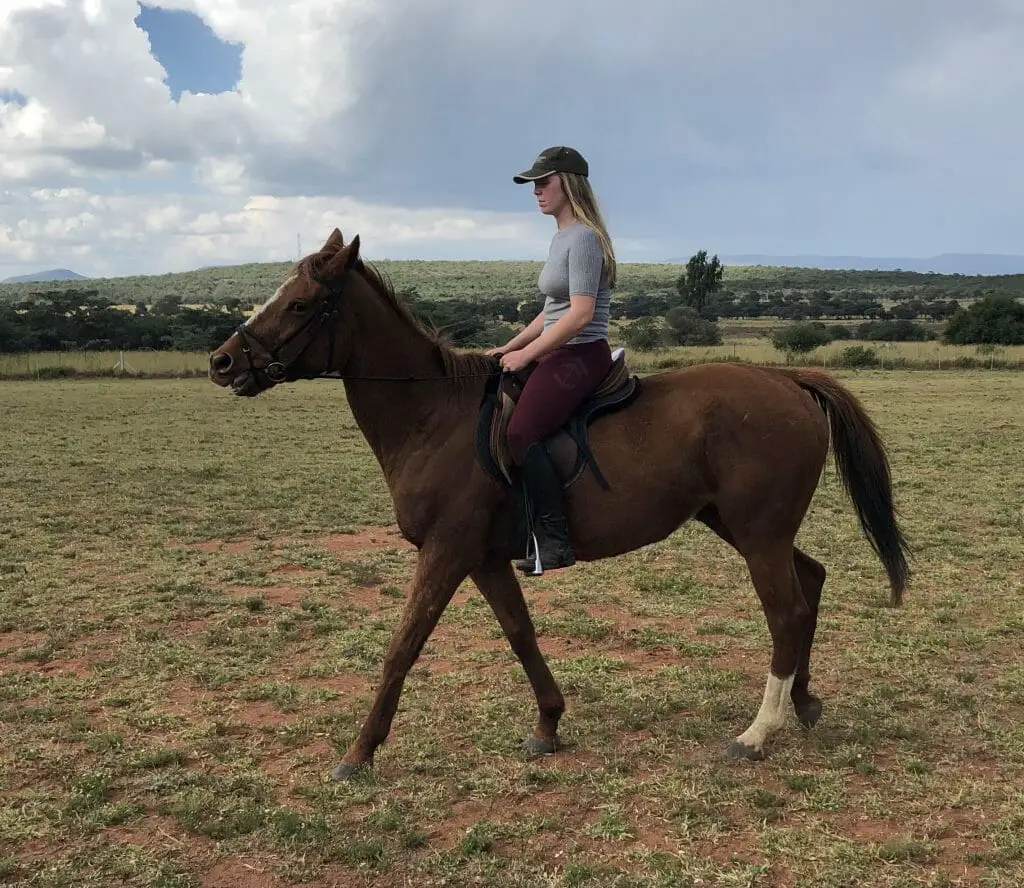
On the forehand, insensitivity to any aids given.
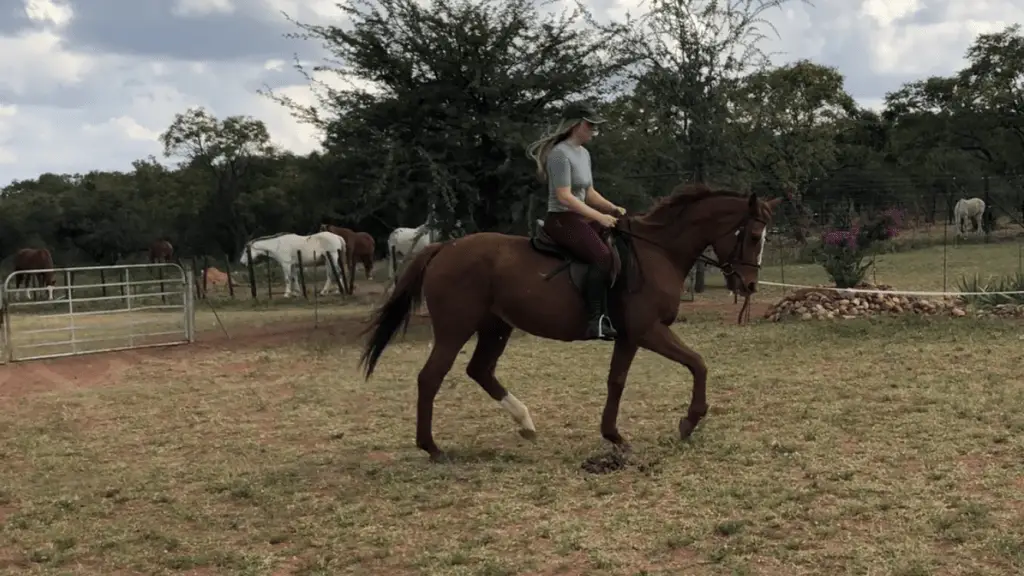
30 minutes and a few simple exercises later, an active horse that listens perfectly to my aids.
Benefit 4: Much less bouncing around in the saddle
It’s extremely difficult to sit those trots and canters when your horse is on the forehand as it means that they’re not using their backs properly.
When your horse relaxes and steering, stopping, and going can be achieved with smaller aids, you’ll be able to sit much more nicely because your horse’s back will have the correct muscles at work and you don’t have to worry as much about giving all those aids all the time.
Benefit 5: Added balance for both you and your horse
I’ve said it before and I’ll say it again, balance! When your horse is unbalanced, they’ll be racing through the arena, cutting off corners and basically turning into a motorcycle by the looks of it.
However, when horse and rider are balanced, you’ll be able to go all the way into the corners of the arena and you’ll be making turns without your knees nearly touching the ground.
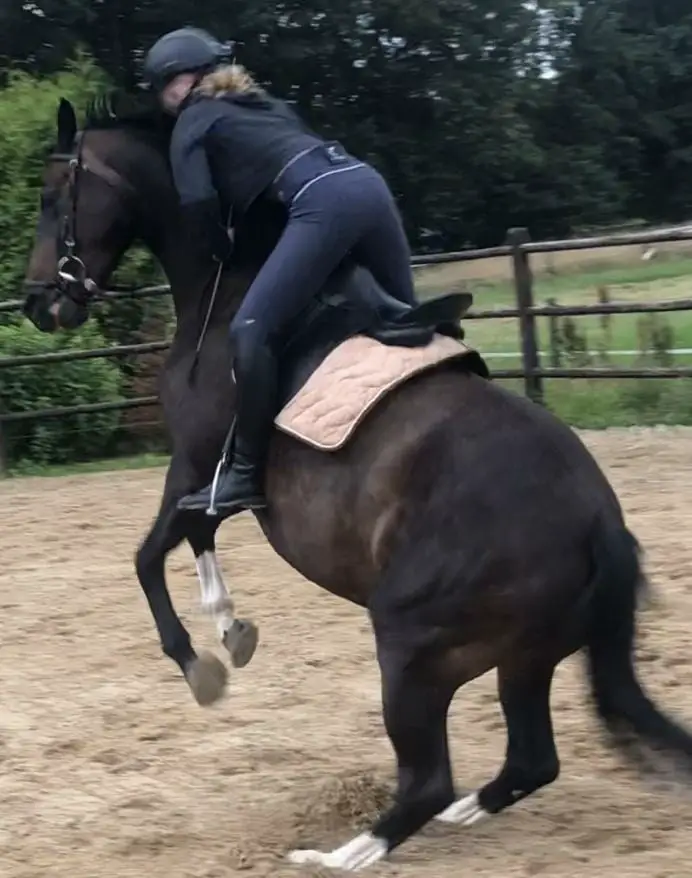
An unbalanced horse and rider makes for some… pretty embarrassing situations.
Benefit 6: You’ll have a much easier time getting around the show jumping course or practicing any other discipline
How does it sound to go through a course, on a hack or endurance ride without getting exhausted with all the aids you’re giving and a sore bum from bouncing around in the saddle.
You’ll be able to focus more on riding, the thing you actually enjoy so much because your horse listens so well to your aids and is balanced and active. With that, you can also make sure to focus on the actual course in front of you or the nature around you.
Benefit 7: A more solid dressage basis will make dressage fun again
Even if you’ve never enjoyed dressage or have no aspirations to be one of those fancy competition riders, if your horse is improving in their exercises, you might actually start looking forward to those flatwork sessions.
5 Easy Dressage Exercises To Practice With Your Horse
Exercise 1: Release the reins and let’s go!
No, I’m not crazy. I know I just told you that we want to achieve an active bum, a balanced horse and all that dressage stuff.
However, by making your horse ‘just go fast’ for a couple of minutes every day, they’ll start to build muscles in their hind end and build the endurance we want to practice the other exercises. It’ll also help you find your own balance.
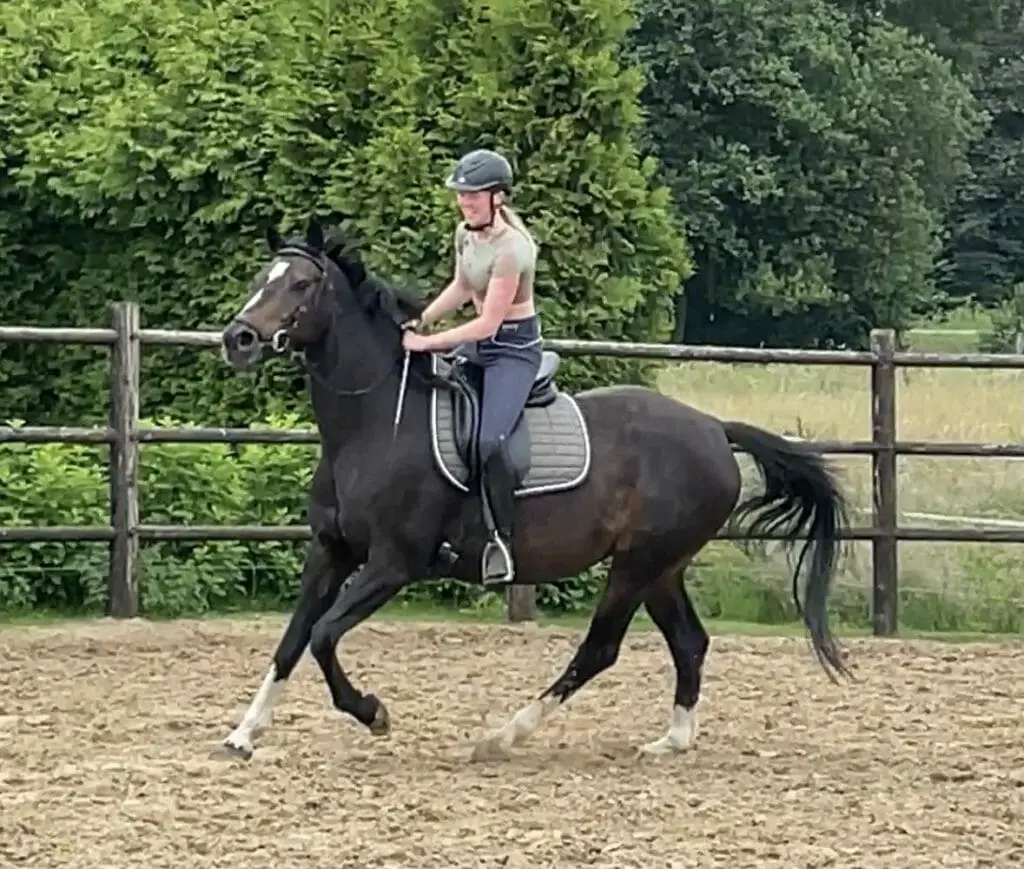
This horse is not very experienced in her canter and therefore we do about 10 laps, left and right, everyday! Lots of fun.
Exercise 2: Figure 8s
Circles, circles and more circles. Try to make a figure 8 at every letter by the side of the arena, or every other letter to start with.
Or try out having someone call out a letter and see how fast you can get there, but only while riding small half-circles!
If you make circles and switch it up between left and right, you’ll feel your horse get softer and lighter on the reins.
Make sure to reward your horse when they lighten up by riding out of the circle and giving them lots of praise and taking all the pressure off the reins.
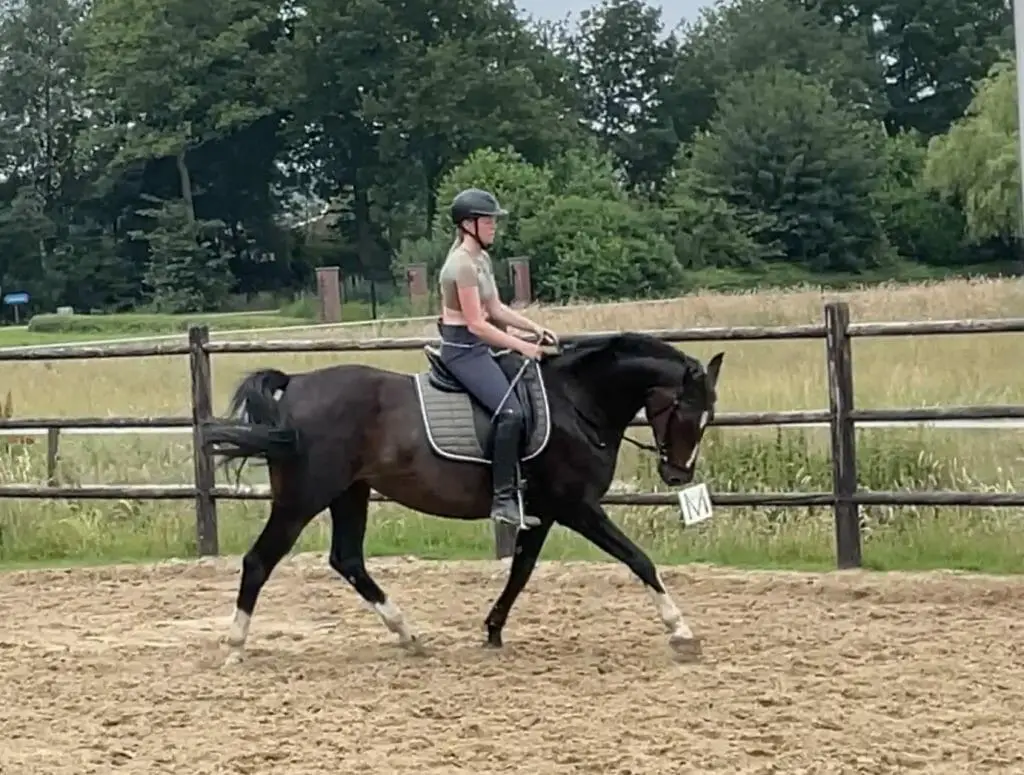
The result of riding figure 8s. Almost no pressure on the reins and an active bum which allows her to really stretch her front legs.
Exercise 3: Leg yields
You absolutely don’t need to do this while riding at the start, but try it from the ground first. Stand by your horse’s shoulder and place your hand just behind where your leg would normally be.
When you first try this exercise, give your horse some extra guidance by placing a hand on or in front of their shoulder as well, as we want the whole horse to move away from you and cross over their own legs.
Slowly increase the pressure of your hands until your horse moves to the side, then stop and give lots of praise!
You’ll notice that every time you try this, you’ll need less pressure to make your horse move and you’ll eventually be able to give the same cue while riding and be able to leg yield.
This exercise really helps improve balance and will teach your horse that they won’t trip over their own legs.
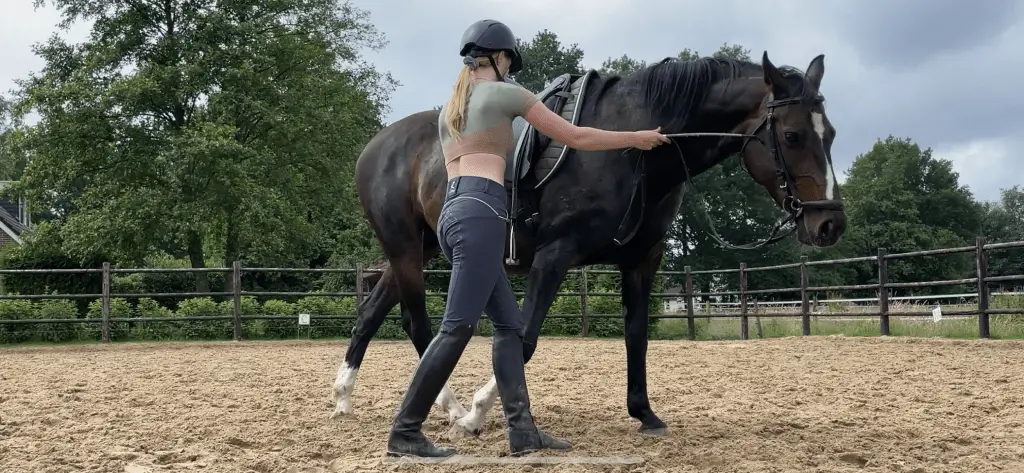
Teaching leg yields on the ground.
Exercise 4: Go for a hack over lots of hills
This is a fun one, and a great first step to riding transitions. If you’re lucky enough to live in an area where you can go for a hack with lots of hills, try to do it as much as possible, in walk, trot and canter.
It will build up your horse’s hind end muscles massively which means they’ll be able to finally activate that booty and stop hanging on the reins!
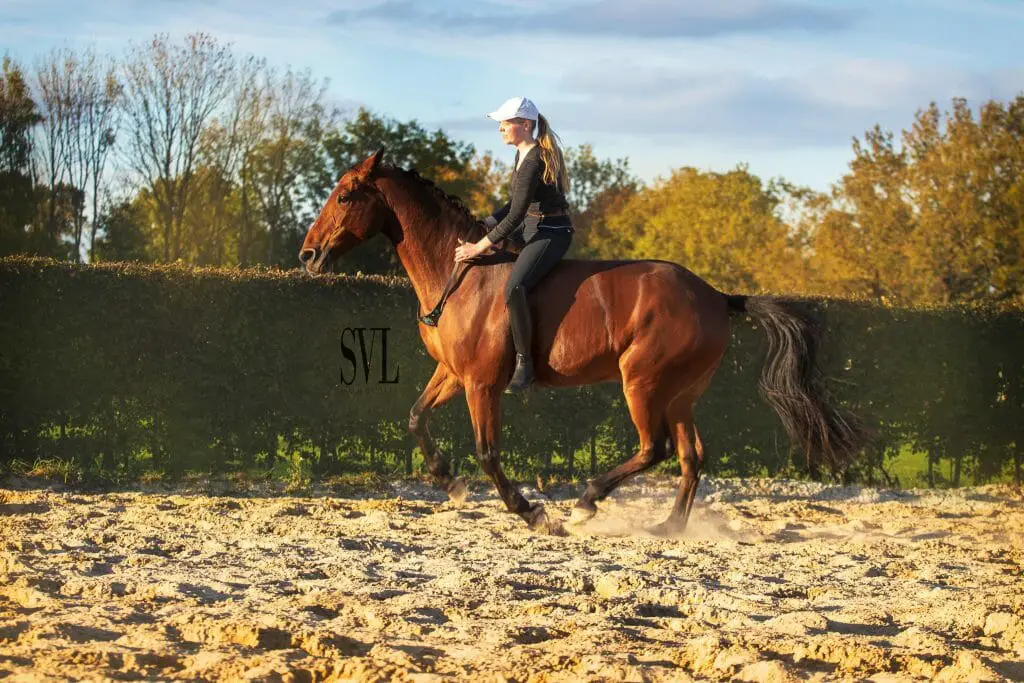
A horse that’s a pro at these exercises will be able to do anything. Just have a look at that active hind end.
Exercise 5: Finally… transitions
Transitions are an incredible tool, it will activate your horse, make you and your horse more balanced and you can stop hanging on the reins to stop your horse. You can start with just the simplest transitions, walk to trot and back, or halt to walk and back.
Make sure to always have some contact with your horse’s mouth, but don’t pull. You might have to give big aids in the beginning, but slowly try to squeeze your horseless and pull the reins less to achieve the same transitions. When you have these under control, move onto trot to canter transitions.
After that, and if you’ve got those completely nailed down, you can basically do any transition. Walk to canter, trot to halt, halt to trot, canter to halt, anything! Don’t be afraid to have a little bit of fun with it either.
Summing It Up
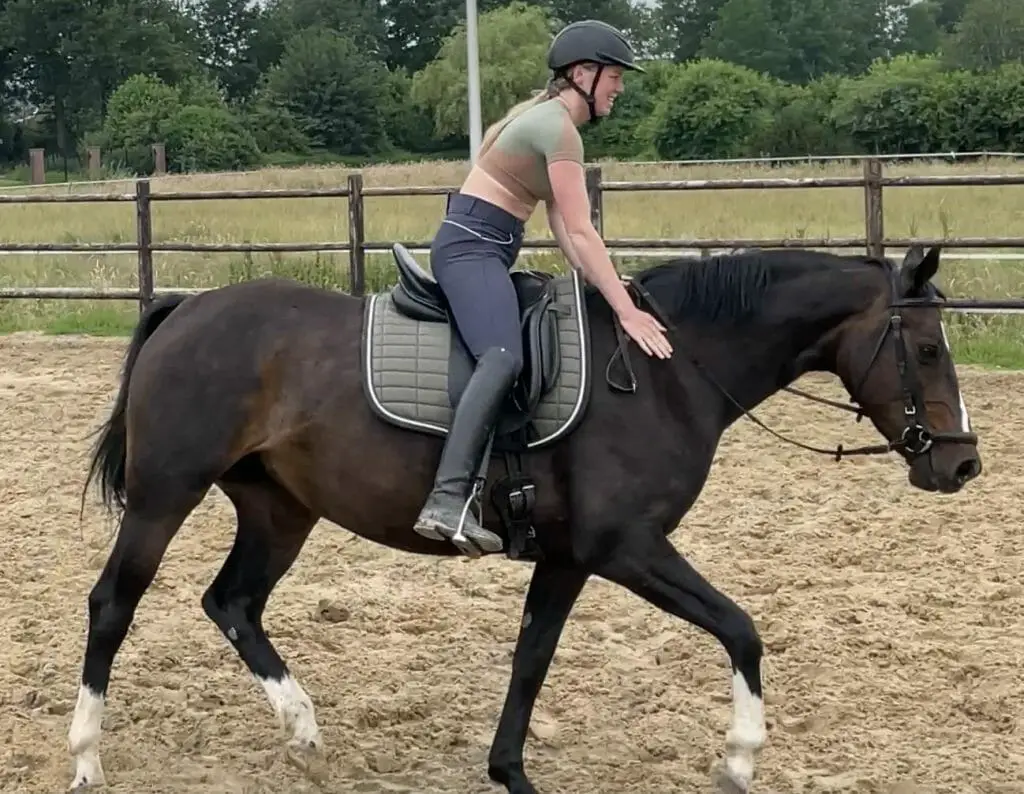
- Don’t forget to give lots of praise to your horse.
- Pulling lots to make your horse stop might make your arms look really buff, but it’s not particularly fun.
- Practicing some easy dressage exercises every once in a while will make riding so much more fun for you and your horse. You’ll end up with a balanced, forward-going, and easy-to-ride horse.
- Anyone is able to practice basic dressage and you won’t need fancy trainers or equipment, but it’s always nice to get tips and tricks from a trainer: Lessons – Hooves Around the World, or just have someone film you and be your own trainer.
- Once you get the hang of it, you might even have fun during those flatwork sessions.

